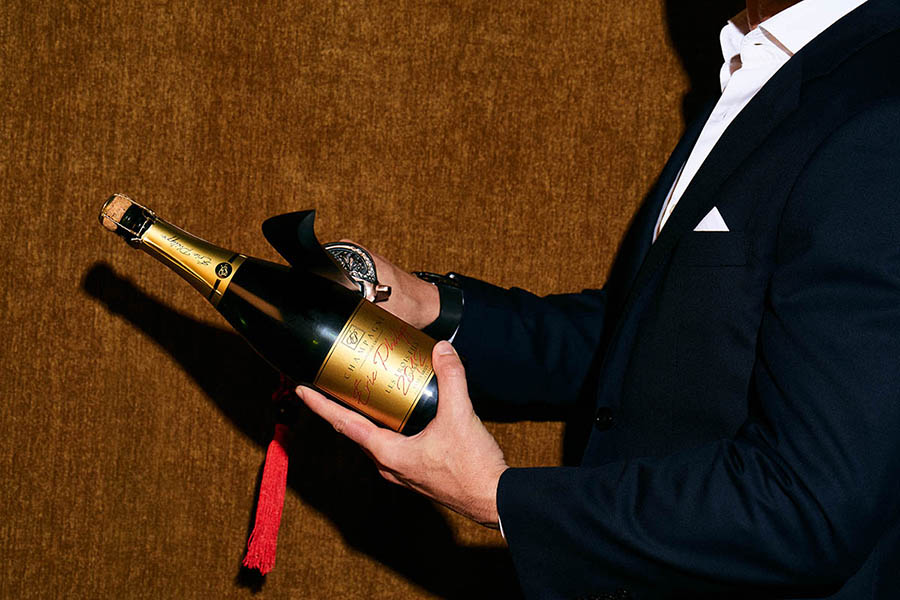
The king and queen of luxury: Champagne and caviar. Is there anything more indulgent, outrageous, or delicious? This classic pairing has been enjoyed throughout history, but what technically is caviar? How do you enjoy it? Most importantly, what do you pair it with? In honor of National Caviar Day, we’re answering all of your questions and inviting you to our caviar & Champagne virtual tasting on Thursday, July 23rd at 3 pm Pacific/6 pm Eastern on Instagram LIVE.
What is Caviar?
Quite simply, caviar is any salt-cured eggs from a sturgeon fish. Salt-cured eggs from a fish other than sturgeon are called roe. Originally acquired from fish in the wild, now the majority of sturgeon are farmed in primarily 13 countries for the express purpose of extracting caviar.
A Brief History of Caviar
Caviar dates back to the time of Aristotle, but it’s the Russian Tsars that truly celebrated and glamorized caviar as a luxury good. In the late 1800s, caviar made its way to the United States and we quickly became the top exporter of caviar throughout the world, eventually trumping Caspian Sea production. In the 1960s, due to overfarming, American caviar supply tanked while demand continued to grow, thus driving up the price. Advances in efficiencies and responsibility have been made, yet it continues to be a laborious process that has left wild sturgeon nearly extinct. Today, China is the top exporter of caviar, most notably their Kaluga Queen caviar.
Types of Caviar
Original Caspian Sea Three
Beluga
Beluga is the rarest and most expensive caviar. It is also illegal in the United States due to over-farming that has led to near extinction.
Ossetra
Ossetra is one of the original Caspian Sea sturgeons and is the most popular of all caviars. Now, Ossetra is farmed throughout the world and can come in a variety of colors, affected by the seas of origin.

Sevruga
Sevruga is the most readily available sturgeon, and therefore the most readily available and affordable caviar. It comes from the Acipenser stellatus sturgeon.
Modern Day Additions and Alternatives
Kaluga
Kaluga, from the freshwater Huso dauricus on the Amur River Basin in China, is the sustainable alternative to Beluga. Kaluga is extremely highly regarded, second only to the elusive Beluga.
Salmon Roe
To clarify, caviar is never the orange color of salmon roe but it makes a tasty alternative. Distinctions amongst salmon roe are similar to caviar– they vary based on the type of salmon the eggs are extracted from. Coho, pink, chum, and sockeye roe, just to name a few, are harvested primarily in and around Canada, Alaska, and Japan.

How to Serve Caviar
According to Russian tradition, caviar tins are placed on ice and served with a mother-of-pearl spoon. A small dollop of caviar is spooned onto the backside of one’s wrist, to be warmed by body heat, and then lapped straight from wrist to mouth where it should be savored. The final traditional step is a palate-cleansing with either low-dosage Champagne or premium vodka.
Nowadays, caviar studded recipes have led to its rise in popularity. Dishes like caviar topped scallops, potato pancakes topped with crème fraîche and caviar, and caviar stuffed omelets all make caviar and roe more obtainable and regularly enjoyable. The most classic of all, the caviar topped blini originated in Russia in the 19th century and continues to be enjoyed and loved by all.

Caviar and Champagne Pairings
Champagne and caviar go together like, well, Champagne and caviar! The pairing is classic – two items equally indulgent, equally luxurious, and equally delicious. We’d love for you to join us as we discuss pairing three of our Eric Philippe Champagnes with three different Osetra caviars from The Caviar Company of San Francisco. We’ll be going live on Instagram on Thursday, July 23rd at 3 pm Pacific/6 pm Eastern. Make sure to order your caviar and Champagne tasting kits today and follow @ericphilippeofficial and @thecaviarco ahead of time. We’ll see you there!




